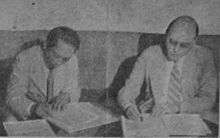Linggadjati Agreement

The Linggadjati Agreement (Linggajati in modern Indonesian spelling) was a political accord concluded on 15 November 1946 by the Dutch administration and the unilaterally declared Republic of Indonesia in the village of Liggajati, near Cirebon in which the Dutch recognised the republic as the de facto authority in Java, Madura and Sumatra.
Background
In 1942, the Japanese occupied the Dutch East Indies. On 17 August 1945, two days after the Japanese surrender, Indonesian nationalist leader Sukarno declared Indonesian independence. The Dutch viewed the Indonesian leadership as collaborators with the occupying Japanese, and were determined to reassert their control over the nation by force.[1] Fighting broke out, which developed into a full-scale war of independence between Dutch forces and Indonesian republicans. By mid-1946, both sides were under pressure to negotiate.[2]
The negotiations
In July 1946, the Dutch invited Indonesians from eastern Indonesia and from rulers of local kingdoms to a conference in Malino, Sulawesi. These delegates backed the Dutch plan for a federal Indonesian state with continued links to the Netherlands.[3] Further negotiations with the Indonesian authorities began in October 1946 and a ceasefire in Java and Sumatra was agreed to and signed on 14 October. Recognizing their still weakened position following World War II, the Netherlands were more prepared to negotiate with the Republic than they were later in the Indonesian National Revolution.[4] Most of the negotiations took place in the mountain village of Linggadjati around 25 km south of Cirebon, although the final document was actually initialed in Cirebon.[5] The Dutch side comprised the following:
- Willem Schermerhorn, Dutch Prime Minister from 1945-1946
- F. De Boer, Liberal politician
- Max van Poll, Roam Catholic Party politician
- Hubertus van Mook, Lieutenant General Governor (ex officio)
On the Indonesian side were:
- Sutan Sjahrir, Prime Minister
- Amir Sjarifuddin, Defense Minister
- Johannes Leimena
Former British ambassador to Egypt Miles Lampson acted as intermediary in the early stages, but he was not needed as the two sides established good relations.[6]. The two sides initialled the draft agreement on 15 November.[7]
The agreement
The agreement comprised an introduction, 17 articles and a final clause. According to the terms, the Netherlands agreed to recognize Republican rule over Java, Sumatra and Madura (Article 1). The Republic would become a constituent state of the federal United States of Indonesia, along with Borneo and the Great East (Articles 2, 3 & 4). The Netherlands Indies, together with the Netherlands, Suriname, and the Netherlands Antilles, would form a Netherlands-Indonesian Union with the Dutch monarch as official head of this Union (Articles 5, 7 & 8). Both the United States of Indonesia and the Union which would be established by 1 January 1949 at the latest (Article 12). Once the agreement was signed, both parties would reduce their armed forces (Article 16).[8][9]
Later developments
On 25 March 1947 the Dutch House of Representatives ratified a 'stripped down' version of the treaty which was, however, not accepted by the Indonesians. Further disagreements rose over the implementation of the agreement. On 20 July 1947 the Dutch administration cancelled the accord and proceeded to commence military intervention in form of the Operatie Product, the first of two events known as politionele acties ('police actions').
After the agreements surrounding the Linggadjati Agreement broke down there was a prolonged period of diplomatic dispute and open conflict in Indonesia for much of 1947 between the Dutch and Indonesian authorities. The United Nations Security Council established a Committee of Good Offices which led to the signing of the Renville Agreement in January 1948 on the USS Renville anchored off Jakarta.
However the Linggadjati Agreement and the Renville Agreement were at best only partially successful. Disagreements and sharp military clashes between the Dutch and the Indonesia sides continued on throughout 1948 and into 1949.
See also
Notes
- ↑ Ricklefs 2008, p. 341-344.
- ↑ Ricklefs 2008, p. 358.
- ↑ Ricklefs 2008, p. 341-360.
- ↑ William & Robert 1993.
- ↑ Wehl 1948, p. 145.
- ↑ Fischer 1959, p. 95.
- ↑ Fischer 1959, p. 96.
- ↑ Ricklefs 2008, p. 361.
- ↑ Wehl 1948, p. 146-148.
References
- Fischer, Louis (1959). The Story Indonesia (4th ed.). New York: Harper & Brothers.
- Frederick, William H. & Worden, Robert L., eds. (1993), "The National Revolution, 1945-50", Indonesia: A Country Study, Washington, D.C.: Library of Congress, retrieved 1 December 2009.
- Ricklefs, M. C. (2008) [1981]. A History of Modern Indonesia Since c. 1300 (4th ed.). London: Palgrave Macmillan. ISBN 978-0-230-54685-1.
- Wehl, David (1948). The Birth of Indonesia. London: George Allen & Unwin Ltd.


